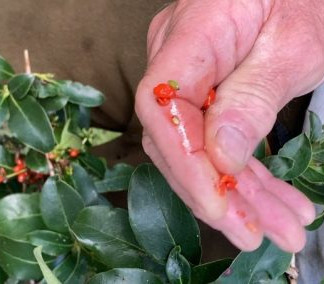
“It’s easy to underestimate what it takes to set up and run a native tree nursery,” says Narida Hooper of Pae Tū Mōkai o Tauira Inc. – a community and environment-focused group based in Featherston.
“When we set up our committee in 2018, we had this idea that we wanted to supply plants to local restoration groups and agencies such as councils and DoC – native plants which were of the same genetic makeup as those already found around the lakes and wetlands. It was such a beautiful kaupapa, but we shelved it because it was also such a beast! Without money, it could only be an aspiration.”
But because of that aspiration – and the thought and planning that had already gone into it then when the government offered funding for shovel-ready projects, Pae Tū Mōkai were ready to start digging. With some nudging and support from the Greater Wellington Regional Council, the group secured funding through community grants, and the nursery began to take shape
“We started with the outside growing yard and then the potting shed,” Narida says. “But then we got to the point where we’d gone about as far as we could on our own. What we needed now was some expert knowledge.”
That pūkenga, that holder of expert knowledge, was Harvey Phillips, who became involved in early 2021. “Harvey was able to give us good advice on how to complete the infrastructure for the yard and shed – things like wind, rabbit and weed protection, shelter and irrigation. “says Narida. “The yard has to be a place where our plants can grow safely.”
“For us, Harvey Phillips is gold. As well as helping us to set up our infrastructure properly, he fits well with the kaupapa of our group and has knowledge of matauranga māori. He also led a wānanga around seed collection, seed cleaning, plant identification, germination and propagation so that we can do this for ourselves in the future.”
The group acknowledges that they have a massive task ahead of them. Part of the challenge will be anticipating which plants the different groups will require when undertaking planting projects. Some groups will be focusing on waterways, others on promoting bird life, and others on restoring wetlands or establishing habitats for inganga or eels.
Having everyone as volunteers is another challenge, one which is shared by many biodiversity and community groups. On-going funding could be an issue. “We would love to get to the point where we could employ someone to help run things,” says Narida. “We’re not currently able to generate any income, but we hope eventually to use money from the plants we sell to upgrade and maintain our equipment. Hopefully, one day we can also create employment opportunities.”
Pae Tū Mōkai o Tauira is based at the old Featherston golf clubrooms. Their focus isn’t just on te taiao, the environment, and ensuring that a māori voice from Featherston is heard at a council level. Future plans include constructing a whare where groups can hold noho wānanga and hui. In the meantime, the group is busy providing opportunities to learn whakapapa of the area, to learn about and be involved in cultural monitoring, and to maintain a hugelkultur plot they’ve developed at the Lake Domain.
One new project is the establishment of regular water monitoring at sites along the Otauira stream. Otauira Stream runs from Remutaka Hill, past the old dump site, past the township, beyond the wastewater treatment plant and meets Donalds Creek and Wairarapa Moana.
“If we’re not monitoring, then we can’t make statements about our waterways and impacts on them,” says Narida. “To see change, we need to have a baseline. Collecting data and observations over time will help us to see the bigger picture, and hopefully, we can identify and create intergenerational environmental change.
“We use a māori lens when we study te taiao, the natural environment. We go back to three key kaupapa – manaakitanga, kaitiakitanga and rangatiratanga. Manaaki is the key to tikanga. If, as Māori, we’re unable to manaaki our manuhiri because our traditional food sources have been contaminated or we are displaced from them, then we lose our ability to kaitiaki our environment. When that’s happening, we’re not exercising our right to rangatiratanga.”
Toitū te marae o Tāne, Toitū te marae o Moana, Toitū te tangata
Protect and strengthen the realms of the Land and Sea, and they will protect and strengthen the People
Article written by Ali Mackisack.






Comments